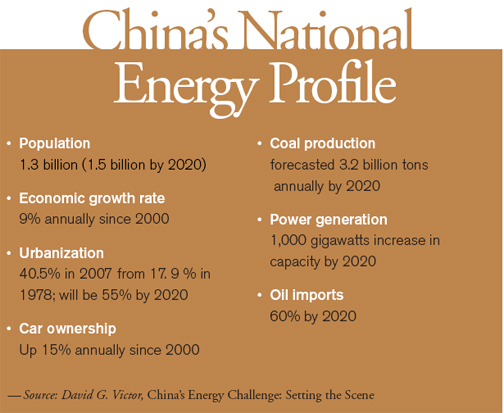- Energy & Environment
Serious solutions to the twin problems of energy security and global climate change hinge on the actions of China and the United States, which are the world’s largest emitters of carbon dioxide, the main human cause of global warming, and the largest users of oil. Other countries matter, but China and the United States are pivotal. Governments in both countries know this and have thus created an ever-growing array of mechanisms for engagement.
The efforts at engagement so far have not achieved much, with the few real achievements in highly specialized areas that are not readily scaled up to serious and broad interaction on energy and environmental topics. Before fruitful negotiations get under way, we need to explore where and how China and the United States could engage with each other.
Most engagement has been fruitless because both the Chinese and American governments have sought interactions that carry few costs and risks, meaning that what passes for engagement does not reflect the underlying interests and administrative capabilities of the two governments. The result is a large number of dialogues but no real impact on the investments and operations that affect energy security and climate change.
The economic crisis is likely to make engagement even harder as both countries focus on internal problems and, as is typical during hard times, demonize their partners as the cause of trouble. Neither country is well served by its failure to promote serious engagement over energy, security, and pressing environmental issues. Doing better requires initiatives on at least three fronts.
First, abandon the bromides that occupy most discussions of engagement. Such bromides are harmful in that they make the Chinese skeptical of anything the U.S. government proposes. Credibility and trust are essential yet still in short supply.
For example, many analysts claim that the United States can engage China by transferring to it advanced technology and that China can contribute by lowering its trade barriers. Such efforts, they aver, would help China cut energy consumption and staunch its emissions of greenhouse gases. Chinese firms, however, already have access to most top-tier energy technologies, including renewable power, nuclear power, advanced coal combustion, and efficient end-user devices. Trade barriers are few, and in some areas (such as advanced coal technology or the manufacture of solar cells) China is producing at the world’s best standard. (India, by contrast, would gain from fuller trade in energy technologies.) This outcome is hardly surprising; China is a world-class manufacturing nation in many areas, and its expertise extends to many energy technologies. Areas where such technologies are not deployed in China are those in which administration of public policies is poor and industry is fragmented—problems that outsiders, such as the U.S. government or industry, can do little to fix.
Second, engagement over oil requires recognizing that the efforts to engage China provide little if any benefit to the country’s core interests and that many are threatening. For China, oil is a strategic commodity (according to the International Energy Agency [IEA], China will depend on imports for 60 percent of its oil by 2030), and sensitivities are high. The United States has spearheaded an effort to enlist China (and India) in the IEA, hoping that doing so would make the operation of Chinese oil markets more transparent and would help integrate China’s strategic oil reserves into the global system of reserves. Yet the United States has as yet not devoted much diplomatic effort to overcoming opposition to China’s membership by existing IEA members, especially those in Europe who fear a loss of influence. Those nations have blocked changes in the rules needed for China to become a member. The United States also demonizes China’s efforts to “go out” to get oil supplies (e.g., in Sudan) and to create a navy and system of pipelines that China feels necessary to secure its oil supplies. From the Chinese perspective, engagement over oil security carries huge risks that its current strategies will be undermined and that new Western-oriented strategies (e.g., membership in the IEA) will fail. Changing those perceptions will require that the United States be more credible in encouraging China to join market-oriented institutions and tolerating China’s need to build capabilities (e.g., an effective coast guard) to secure ship-borne oil. Joint U.S.-China exercises in key supply choke points such as the Strait of Malacca and offshore Somalia could be useful.
Third, engagement over climate change has produced little benefit for either the United States or China. The countries are talking but until recently have done little else. Washington has leaned on Beijing to take a more positive stance on climate change; Beijing has responded handsomely in the last two years. Some of China’s analysts claim that their country is doing more to control climate warming emissions than any other—a claim that is too bold to be true—but China is certainly headed in that direction. Movement on the issue inside China has come not from an epiphany about the dangers of global warming but from Chinese planners finding many areas, such as energy efficiency, in which local priorities, including energy security and pollution control, align with global needs. Both China and the United States, however, are still struggling to find useful things to do together.
The root cause of the struggle has been the lack of a U.S. policy on controlling emissions. Even as that changes—thanks to more climate-friendly policies on the American coasts and the (albeit slow) efforts to devise a national policy in Washington—there remains little to bring the United States and China together. Yet China is the world’s largest emitter of greenhouse gases; no scheme for protecting the climate can be effective or politically sustainable without visible progress in China. This means that the United States must abandon efforts to include trade sanctions as part of U.S. climate legislation; such measures threaten to damage the one area in which the United States and China have successfully engaged (i.e., trade and the World Trade Organization). Politically, such a move will be difficult to advance in Washington: the labor unions and Rust Belt politicians are strong, and supporters of trade sanctions and their votes are key to passage of climate legislation. Finding acceptable climate change proposals will require identifying those areas in which China can make policy changes that align with its underlying interests and reduce emissions. Most offers of engagement, such as the joint development of new power plant technologies, have not been viewed by the Chinese government as credible because of the United States’ poor track record in sustaining such promises.
Absent such a constructive alternative, China’s major mode of engagement with the climate debate has been through investments (mainly from Europe) under the Kyoto Protocol’s Clean Development Mechanism (CDM). A careful look at those investments shows that most do not reduce emissions; until there is an attractive alternative, however, China will continue to view the Kyoto Protocol’s CDM as the only carrot for engaging with the outside world on climate change.
Discussions about engagement have drifted from reality in part because they have lost sight of the important connection between international engagement and national policy. Most of the heavy lifting in international affairs is done through national policy because international institutions are weak. For this reason, the two countries might do better to signal tacitly to each other areas for engagement through stronger actions at home. For example, both countries could make more serious efforts to control emissions and to limit the demand for oil; they could also make their domestic markets more open to cross-investments that could, in turn, accelerate the diffusion of technology in both directions. Firms and investors, rather than governments, may prove to be the more consequential actors.
Although the history of engagement efforts is not promising, I think the signs are hopeful. Energy officials from the Obama administration are spending more time in China listening to the new realities that will force the United States to get more serious. Although China’s system for investing and deploying new energy technologies is still flawed, it is a rapidly rising player. That rise gives China options, requiring potential partners, such as the United States, to be more relevant. The most substantive announcements of U.S. international policy during the run-up to the Copenhagen conference on global warming came from joint U.S.-Chinese communiqués, including encouraging news of a fresh round of U.S.-China efforts to cooperate on energy, though the size of the planned effort ($15 million per year) is still too small to be relevant. Also, during the past two years Chinese officials have been changing their tune on global warming, in part because they feared that China would be blamed for the world’s inability to reach serious agreements. Today, the spotlight is on Washington’s gridlock.
What’s at stake here isn’t just the U.S.-China relationship but the vision of how big, important countries can solve common problems. None of the existing international institutions, such as the IEA, the G-8, or the G-20, seems well organized enough to solve problems such as the world’s perennial underinvestment in energy research and development. For China, especially, those institutions do a poor job of representing Chinese interests. The United States and China can fix such problems by finding meaningful ways to cooperate and understand each other. They still have a long way to go.

















